
--Patanjali


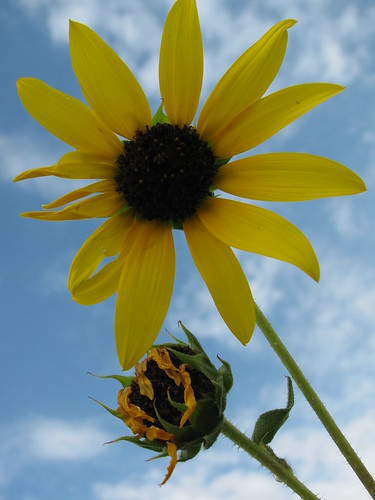
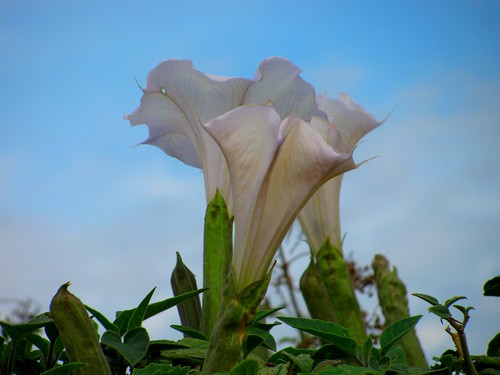
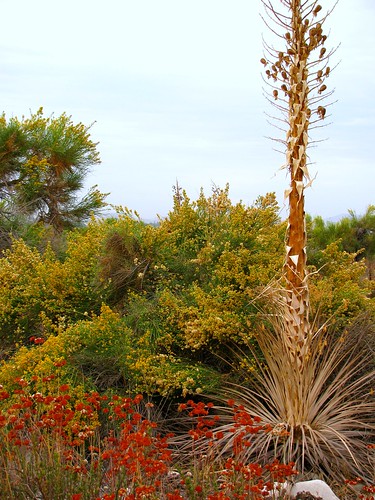

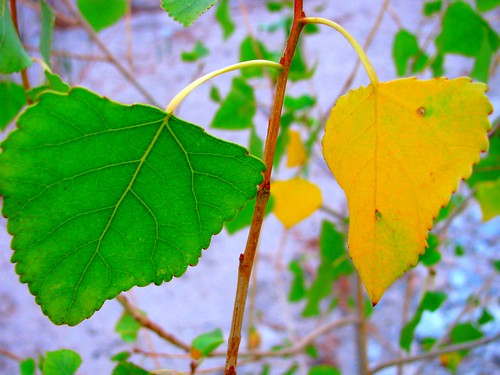

"Long ride ahead of you, going to Bangkok, right?" he said, grinning.
"Indeed, I am. You, too?" I asked. He nodded.
In fact I was unsure as to how long the ride would really be, having heard or read everything from 12 to 17 hours.
I learned from my seat mate that he spent most of his time between Costa Rica and Chiang Mai, in northern Thailand, but this time had decided to detour and check out the Cambodian coastal town of Sihanoukville, where I'd spent the last week.
"So, what did you think of the place?" I asked.
"Well, I don't know if this will make sense ... it had a very low energy, ya know, compared to Chiang Mai. Up there the people are so different, high energy," he said, adding: "I guess after having a million of your teachers, doctors, your educated, killed off, that does something to you. I think it's affected the gene pool. It will take some more time to recover, I suppose."
The bus grew hotter, idling in the sun with the AC blowing weakly from the vents above. We weren't sure what we were waiting for and no one had bothered to ask. Finally, after another half hour had passed and the conversation had shifted from Buddhist meditation to goats on bush taxis, a young French couple rushed onto the bus and plopped down in the front seats. They were both sweating and looked frazzled. Minutes later the driver appeared and we finally hit the road.
Five hours later, after a lunch stop in the border town of Koh Kong, we arrived at the the border post in the same town and were promptly dumped off. The Cambodian immigration line, though slow, moved steadily. From there it was a short walk to the Thai immigration office, which processed everyone much quicker than its Khmer counterpart.
On the Thai side there were a series of minivans with their drivers recruiting people to their respective vehicles. Other men had brought our luggage over on large pushcarts. We soon realized that we would not be able to leave until our van was full -- 10 people. Luckily, our driver was zealous in his recruitment tactics. We ended up with the late French couple, a Dutch couple, a Frenchman with a blond toddler in tow, my seatmate from the first bus and two Khmer girls.
The driver's helper came to check everyone's tickets, at which point the Dutch and French couples claimed to have given their full tickets to the boy on the first bus. The ticket checker stated that they could not take anyone without a ticket. So both couples began sifting frantically through the contents of their pockets and packs. After a few minutes the Dutch exclaimed in triumph, producing their tickets from a backpack, whereas the French looked on dejectedly, not able to find theirs. The French couple told ticket man that they had their receipt and stickers for Bangkok, but no tickets; however, the man was adamant about having the tickets and declared that he would need 200baht from them so he could cross back through the border checkpoint and call the ticket office. The French lamented having no baht on them, but the Dutchman quickly came to the rescue and produced 200 baht, to the profuse thanks of the couple. All the other minivans were long gone by this time, and the French couple seemed to sink a little lower in their seats, embarrassed at being the ones to make us late for a second time that day.
The AC was again inadequate, with the Dutch couple and I suffering in the very back. At regular intervals the Dutchman would doff his baseball cap and stick his balding head directly beneath the vents. The Frenchman, meanwhile, seemed to miss the fact that his child was suffering in a thick, long-sleeved jersey.
After zenning it thru this ride for another few hours, we made it to Trat, where at a gas station a lone, white super-minivan was awaiting us. This wonder had high ceilings, twice the space and a freezing AC.
For this final leg of four and a half hours, we all stretched out in cool comfort, thinking that the rest of the trip would be smooth sailing into Bangkok. After being on the road for about an hour we reached a police checkpoint. Most vehicles were waved through quickly, but when we made it to the front of the line a cop gestured for us to pull over. He first asked for the driver's documents, then told him to get out of the van and come with him. No one in the van said a word, but the big UH OH in everyone's minds was almost tangible. We looked on helplessly as they took him to a table and began questioning him.
A little later another officer opened the van's sliding door and peered in, rather menacingly, at all of us. He then ordered the two Khmer girls out and slammed the door shut after they had climbed down. We watched as he questioned them while studying their passports closely. At this point all manner of scenarios were running through my mind and everyone was gazing at each other quizzically.
After another half hour had passed our driver returned to the van. It was hard to tell if he was crying or just sweating profusely, perhaps both. He certainly looked dejected, but he got in without saying anything. The van was eerily silent, not even the toddler was babbling as if he understood the mood. We pulled out of the checkpoint and continued on our way as if nothing had happened.
Around 60 songs later the lights and skyscrapers of Bangkok came into view, with the Frenchman stretching giraffe-like toward the windows to take it all in. After a mere 12.5 hours we had made it to the Bang.

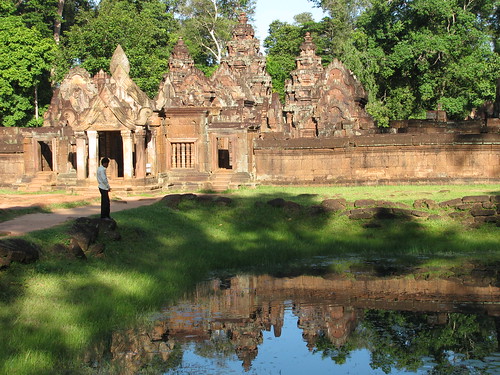
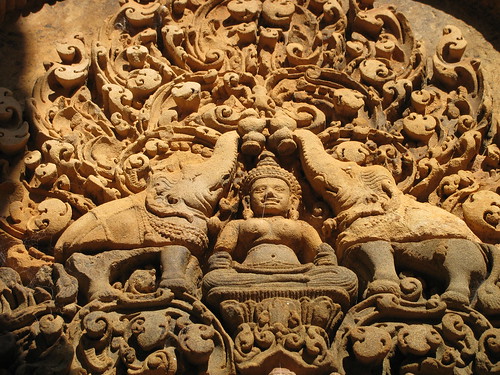
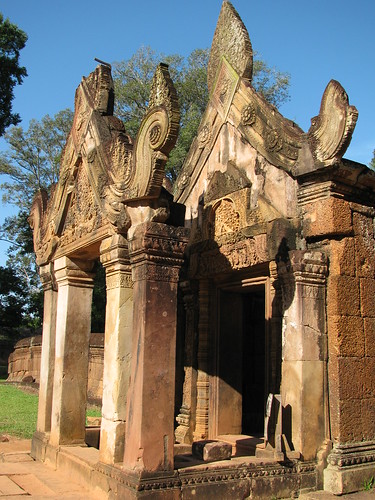
 1. Monkeys around Wat Phnom
1. Monkeys around Wat Phnom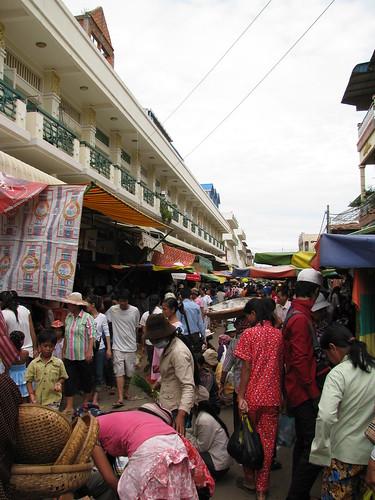 2. Pajamas on the street
2. Pajamas on the street 3. Courtyard gardens at the National Museum of Cambodia
3. Courtyard gardens at the National Museum of Cambodia 4. Architecture, Psah Thmei (Central Market)
4. Architecture, Psah Thmei (Central Market) 5. A true center, Wat Phnom and park
5. A true center, Wat Phnom and park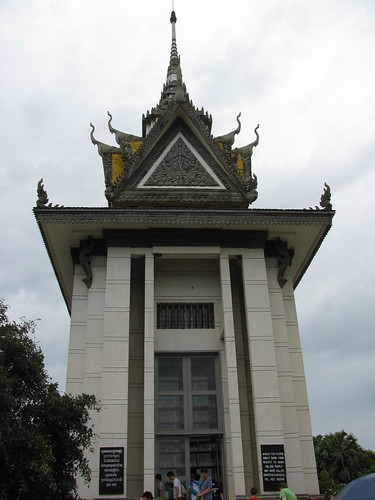 The memorial at Choeung Ek is in the form of a Buddhist stupa. Behind tall windows on all four sides are thousands of skulls from those who were executed here.
The memorial at Choeung Ek is in the form of a Buddhist stupa. Behind tall windows on all four sides are thousands of skulls from those who were executed here.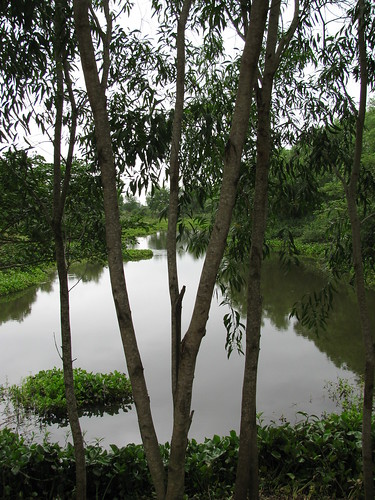
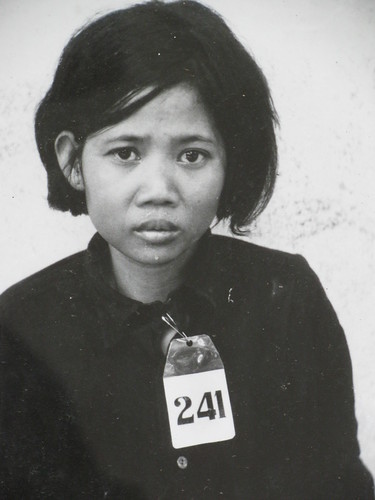 After the Killing Fields I continued on to the Toul Sleng Genocide Museum, the site of the infamous S-21 prison during the reign of the Khmer Rouge. Torture was routine at S-21, including the practice of waterboarding which we all became refamiliarized with in the former US administration.
After the Killing Fields I continued on to the Toul Sleng Genocide Museum, the site of the infamous S-21 prison during the reign of the Khmer Rouge. Torture was routine at S-21, including the practice of waterboarding which we all became refamiliarized with in the former US administration.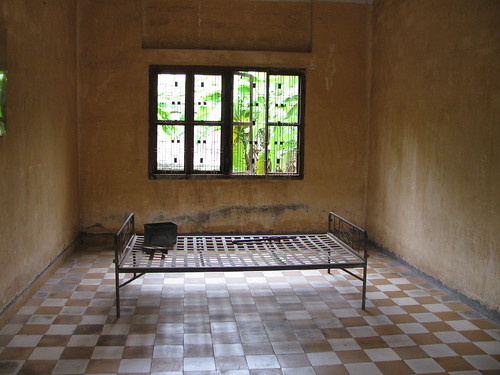 Earlier that morning I had read an article on a top Khmer Rouge interrogator. In his testimony, Mam Nay "expressed no remorse for the killings of thousands of Cambodians who he said had all committed crimes."
Earlier that morning I had read an article on a top Khmer Rouge interrogator. In his testimony, Mam Nay "expressed no remorse for the killings of thousands of Cambodians who he said had all committed crimes."

 While in Chennai, India, in late June I spent a morning strolling the paths of the Theosophical Gardens. On the same grounds lies the headquarters of the Theosophical Society. There are examples of the places of worship of all world religions scattered throughout, but the gardens themselves were what I came for. Unfortunately, the hours that the gardens are open are limited, only a few hours in the morning and another few in the afternoon and the men at the gate are pretty strict about this, though I doubt anyone would come hunt you down if you didn't leave at the set times.
While in Chennai, India, in late June I spent a morning strolling the paths of the Theosophical Gardens. On the same grounds lies the headquarters of the Theosophical Society. There are examples of the places of worship of all world religions scattered throughout, but the gardens themselves were what I came for. Unfortunately, the hours that the gardens are open are limited, only a few hours in the morning and another few in the afternoon and the men at the gate are pretty strict about this, though I doubt anyone would come hunt you down if you didn't leave at the set times.

 June 15: Ghorepani to Tadapani
June 15: Ghorepani to Tadapani June 12: Marpha to Ghasa
June 12: Marpha to Ghasa Ghasa to Tatopani: Today was a descent into what looks and feels most like a tropical rain forest, with banana trees, towering canopies, ferns, waterfalls, and, of course, steamy rain.
Ghasa to Tatopani: Today was a descent into what looks and feels most like a tropical rain forest, with banana trees, towering canopies, ferns, waterfalls, and, of course, steamy rain. June 14: Tatopani to Ghorepani
June 14: Tatopani to Ghorepani Muktinath to Kagbeni
Muktinath to Kagbeni Kagbeni to Marpha
Kagbeni to Marpha June 9: Thorong High Camp to Thorong-la Pass to Muktinath
June 9: Thorong High Camp to Thorong-la Pass to Muktinath June 7: Manang to Yak Khakar
June 7: Manang to Yak Khakar Yak Khakar to Thorong High Camp
Yak Khakar to Thorong High Camp